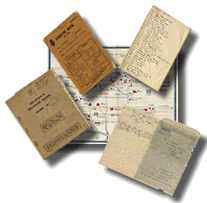General Forms And Documents
Return To General Documents Index
BAGGAGE
Overview
......The amount of baggage the servicemen were allowed to take/send depended on whether they embarked from the U.K. for India before 4 September 1939 or after the 3 September 1939 this was posted on the notice boards; on I.A.O. 43/S/45; or verbally by the baggage staff.
......Cabin Baggage: This was taken with them into their cabin, and would have been personally cleared by the owner through customs when they reached the U.K. It was stressed that cabin space was of a premium, and that this may not be possible on some ships, therefore the baggage would have to be placed in the baggage room, even so the baggage weight limit was set at 1 cwt.
......"Not wanted on Voyage": This would have been loaded directly
into the ships baggage room by Movement Control and a receipt issued. Upon
arrival in the U.K. the baggage would be put ashore for them and they must
clear it through customs either by themselves or through the use of an
agent on production of Customs declaration form, then he/she would have
arranged for the baggage to be dispatched to their home, payment for the
agent was the servicemen’s sole responsibility, the receipt for which
could be sent to Oi/c Army Pay Office (Officer accounts) Manchester, to
reclaim a refund. This baggage was also not to exceed 1 cwt.
......During the voyage the servicemen were required to itemise the contents
and of their baggage and this list was to be handed to Customs by the agent.
......"Unaccompanied" baggage: After deducting the 1 cwt weight limit allowed for each of the above categories, this then constituted their “Unaccompanied” baggage and would be shipped to the U.K. free of charge through M.F.O. unless the servicemen had made other arrangements, a refund for this could be applied for by completing a form at Annexure 'B' and dispatching it to the Audit Officer.
......Air Trooping: The following kit only may be taken in the plane, 1 suitcase 30" x 24'" x 12" gross weight 50 Ibs, 1 haversack or attache case gross weight 10 Ibs, 2 blankets and 1 greatcoat and the balance of their baggage was sent through M.F.O. from the HBTD.
......Procedure: Their excess baggage was placed in the Camp Baggage Room,
stacked alphabetically and documents exchanged within 48 hours of arrival.
......When the servicemen were aware of the ship they were to be traveling
on, were responsible for marking the ship's letter on their baggage which
was then termed as "frozen" and access to the baggage would be
denied until it reached it’s destination. On the Special train to
the Ship cabin baggage could travel with them, but not their bed rolls.
......B.O.Rs: Servicemen were to take all their baggage to their billet, insuring all their baggage was marked with their name, address, ships letter and Draft Number. One kit bag was allowed to accompany them aboard the train, the remainder of which they were entitled would be stacked as per Draft arrangements and would not be seen until it arrived home.
......Re-packing: Servicemen were able to return to the Baggage Room and
reorganize their baggage until it was “Frozen”.
......All the service personnel were advised to keep to hand warm clothing
because of the change in climate.
Packaging:
......They were advised to rope their hold baggage or on payment have the
baggage crated-at the Baggage Room.
Marking of Baggage:
"Cabin” baggage
1. Rank, name U.K.
address
2. The word Cabin
3. Ship's letter when advised by HB1L
"Not wanted on voyage" baggage
1. Rank, name U.K. address C/o
Agent P.O.D. U.K. (the
word ‘agent’, unless know in advance to
whom they were going to give the job to)
2. The words "Not wanted on voyage"
3. Ship's letter when advised by HBTU.
"Unaccompanied" Baggage
1. Rank, name U.K. address C/o Agent if they prefer it, see 2(c) above.
2. The word "Unaccompanied"
3. The words "Thro Embn HQ Bombay"
4. MFO in "2" letter Red on White background.
......Paint for marking baggage was supplied at the SW rooms and everyone
was advised to mark all baggage clearly.
......As their baggage may have to be manhandled by them, it was advised
to keep it manageable also to enclose two labels inside packages giving
their rank, name and U.K. address. Sign writers were available as a paid
service.
......Baggage not wanted on the voyage traveled in the same ship as the
traveling servicemen, but “Unaccompanied” baggage traveled
on a separate ship, and expected to arrive within a month of the servicemen’s
disembarkation.
MEDICAL
Arrangements
......It was strongly advised to report any illness immediately as there
had been cases of servicemen who had died through not doing so. There was
always an Orderly Medical Officer on duty and would have been contacted
through the Duty Officer in their camp.
......Notice boards displayed the times and places of sick parades. Mepacrine
was still being taken, issued from the M.I. Room; and one tablet was taken
for 28 days after leaving an area where it is compulsory. Deolali was not
normally one of those areas.
......Medical Inspections were carried out after their arrival, the M.O. would examine the servicemen to satisfy himself that they were free from any infectious disease, vaccinations and necessary inoculations are up to date. Officers were required to take their AFB-439 and IAFsM-1240 and 1260, B.O.Rs. their AB-64 Part 1.
......Should their inoculations/vaccinations not be up to date they were to be inoculated or vaccinated as required. Warning the personnel that refusal of vaccinations would result in them being placed in isolated quarantine for 14 days before they were allowed to embark.
P 1 :: P
2 :: P 3 :: P
4 :: P 5 :: P
6 :: P 7

Research
